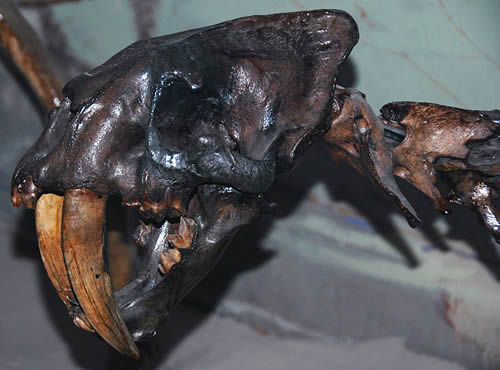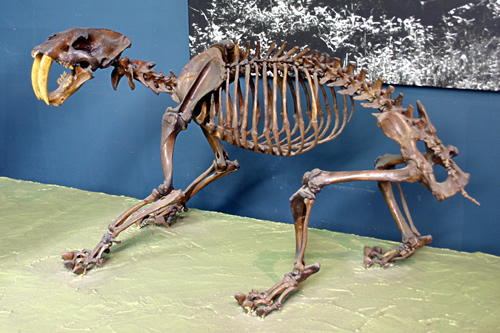Smilodon
Richard P. Hilton and Joe Medeiros
Sierra College
Smilodon was designated the State Fossil of California in 1973. Often referred to as the saber-toothed tiger it was neither closely related to tigers nor to modern cats. It was first discovered by modern science in South America in 1842 and found again in 1881 in the La Brea tar pits of the Los Angeles Basin. Tar pits form where rock layers containing oil and water intersect the surface of the earth and gradually seep out. The volatile portion of the oil, the part that we make gasoline from, readily evaporates leaving the tar and water behind. (When refineries make gasoline, the tar byproduct is then used to produce asphalt.)
During the Ice Age (Pleistocene Epoch, between 2.5 million and 10,000 years ago), Ice Age mammals frequented the tar pits, lured by water that pooled up. Occasionally, herbivorous animals (mammoths, mastodons, camels, horses, deer, bison, ground sloths, etc.) would wade in to get a drink and become mired in the tar. Carnivores such as Smilodon, dire wolf, American lion, coyote, fox, short-faced bear, etc. would then attack the animals in distress, but they too might become entrapped. Flying carnivorous birds like hawks and eagles, and scavengers like condors and vultures might notice the mired animals, then become victims themselves.

Saber-tooths Were Plentiful
The tar pits consequently became well-preserved graveyards of representative animals of the Ice Age, especially the carnivores and scavengers. The second most common vertebrate to be entrapped were the saber-toothed cats. Only dire wolf fossils are more numerous in the tar pits.
The development of saber-like teeth in cats or cat-like animals has evolved more than once, even a saber-toothed marsupial (pouched mammal) in South America. Smilodon evolved late in the Pleistocene.
Over many years of fossil collecting, La Brea has yielded hundreds of thousands of Smilodon bones. Many of them reveal serious breaks that have healed while others show evidence of arthritis. A solitary sick or wounded predator usually does not last long in the wild, so some scientists speculate that Smilodon may have hunted in groups as lions do today. Sharing meals would allow a sick or injured animal to live a longer life. Saber-toothed cats were slow in comparison to modern cheetahs and lions and were most likely ambush predators, probably preying on large ground sloths and other Ice Age herbivores.
Muscles and Teeth
This formidable predator was nearly twice as heavy as modern lions but lacked a long tail and stood about a foot shorter. Smilodon probably used its powerful limbs to subdue its prey while their 8-inch long canines were thrust deep into the animal. These teeth were its most imposing feature, and while their precise function is still debatable, it is presumed that they probably struck a single fatal blow to the abdomen or neck of their prey. Wide-opening jaws accommodated the long weapons. Curved and blade-like with serrations on both edges, the teeth were like curved, double-edged steak knives.
The left fibula (lower leg bone) of a cat closely resembling Smilodon was found in Hawver cave on the American River near Auburn California.
The La Brea Tar Pits and Page Museum in Los Angeles is a great place to learn about Smilodon and the many animals and plants with which it existed.
https://tarpits.org/
Our Museum's Tar Pit Display
The Sierra College Natural History Museum has a wonderful display from a tar pit found on the southwestern edge of the San Juaquin Valley. It contains Ice Age fossil bones from camel, horse, eagle, turkey, tortoise, dire wolf, coyote, American lion, and others.
https://www.sierracollege.edu/museum

Other Resources
- Numerous states have designated dinosaurs and other fossils as state symbols, and many of these are featured at:
https://statesymbolsusa.org/categories/dinosaur-or-fossil - This site illustrates California’s saber-tooth:
https://statesymbolsusa.org/symbol-official-item/california/state-dinosaur-fossil/sabre-tooth-cat - UC Berkeley’s Museum of Paleontology starts their discussion of the saber-tooth as follows:
With their enormous, deadly-sharp canines, sabre-toothed carnivores are well known to many people as frightening and ferocious predators of the Cenozoic.
http://www.ucmp.berkeley.edu/mammal/carnivora/sabretooth.html - The Illinois State museum also has a good description of their saber-tooths at:
http://exhibits.museum.state.il.us/exhibits/larson/smilodon.html - And here’s a pretty cool saber-tooth dramatization to watch on YouTube:
https://www.youtube.com/watch?v=Zl45KKTd2JU - Smilodon image: By James St. John [CC BY 2.0 (http://creativecommons.org/licenses/by/2.0)], via Wikimedia Commons
- Smilodon mount Wikipedia Commons
